WHAT'S NEW:
BACKGROUND:
Mission
Project Description
Cruise Plans:
Participants
Technology (ROV, ships, etc.)
Future Plans
Results:
1998 NeMO Cruise
Axial 1998 "Eruption"
Logbook
June 22, 1999
June 22, 1999
Contents:
- News from Thompson
- News from Wecoma
- Participant Perspective
- Logbook from Teacher at Sea
- Question/Answer from shore to sea
Thompson Science Report
Science Report - Tuesday, June 22
Ships Location: 45 56.0/-129 58.7
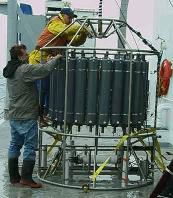 The
Thompson is now on station over the 1998
lava flow at Axial Volcano. We arrived here yesterday evening, and
the first task was to turn on the navigation
transponders that we left behind here last summer. Since then, ROPOS
has gotten wet twice, but we havent seen the bottom yet. This is because
of complications related to removing air from ROPOSs hydraulic system,
and communication problems with the fluid sampler. Neither of these are
serious and will be worked out soon. This is fairly typical for an oceanographic
research cruise. The ROPOS system is very complex and it often takes a
day or two to work out problems before things get going smoothly. Basically,
if anything is going to go wrong, it usually happens in the first few
days. In the meantime, we have completed one
CTD cast (above photo)
The
Thompson is now on station over the 1998
lava flow at Axial Volcano. We arrived here yesterday evening, and
the first task was to turn on the navigation
transponders that we left behind here last summer. Since then, ROPOS
has gotten wet twice, but we havent seen the bottom yet. This is because
of complications related to removing air from ROPOSs hydraulic system,
and communication problems with the fluid sampler. Neither of these are
serious and will be worked out soon. This is fairly typical for an oceanographic
research cruise. The ROPOS system is very complex and it often takes a
day or two to work out problems before things get going smoothly. Basically,
if anything is going to go wrong, it usually happens in the first few
days. In the meantime, we have completed one
CTD cast (above photo) 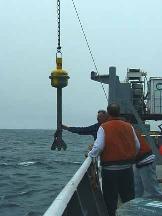 (to get background water samples) and four rock cores (photo right) (to
collect basalt samples on Axials south rift zone). We were also visited
by a group of Dalls porpoises (calendar photo) today. Right now ROPOS
is being prepared for another dive, that will concentrate on recovering
many of the instruments and samplers that have been deployed since last
year. The science party is anxious to see how the 1998 lava flow may have
changed. Will the vents we saw last year still be active? If so,
will their chemistry have changed? Will the animals communities be different
at the vents? Stay tuned!
(to get background water samples) and four rock cores (photo right) (to
collect basalt samples on Axials south rift zone). We were also visited
by a group of Dalls porpoises (calendar photo) today. Right now ROPOS
is being prepared for another dive, that will concentrate on recovering
many of the instruments and samplers that have been deployed since last
year. The science party is anxious to see how the 1998 lava flow may have
changed. Will the vents we saw last year still be active? If so,
will their chemistry have changed? Will the animals communities be different
at the vents? Stay tuned!
Wecoma Science Report
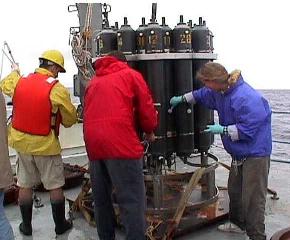 The principal activity of the Wecoma cruise is to map and sample the hydrothermal
plume formed when hot fluids issuing from the crust mix with ambient seawater.
This work provides information on the chemical composition of the hydrothermal
fluids. In combination with the mooring work, it will also allow us to make
estimates of the total rate at which heat and chemicals are supplied to
the ocean around Axial from the eruption. Here scientists sample seawater
collected in plastic sampling bottles almost a mile below the sea surface.
Inside the ring of sampling bottles is a CTD--conductivity, temperature,
and depth--instrument that senses the temperature and optical intensity
of the hydrothermal plume. When plume water is encountered, a scientists
sends a signal to the CTD to close a bottle and capture a water sample.
The principal activity of the Wecoma cruise is to map and sample the hydrothermal
plume formed when hot fluids issuing from the crust mix with ambient seawater.
This work provides information on the chemical composition of the hydrothermal
fluids. In combination with the mooring work, it will also allow us to make
estimates of the total rate at which heat and chemicals are supplied to
the ocean around Axial from the eruption. Here scientists sample seawater
collected in plastic sampling bottles almost a mile below the sea surface.
Inside the ring of sampling bottles is a CTD--conductivity, temperature,
and depth--instrument that senses the temperature and optical intensity
of the hydrothermal plume. When plume water is encountered, a scientists
sends a signal to the CTD to close a bottle and capture a water sample.
Listing of all Science News postings
Life at Sea: Participant Perspective
Maia Tsurumi (left) and Jean Marcus (right)
Graduate Students,
University of Victoria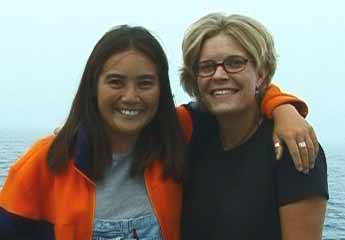
June 22, 1999
Day 2 of NeMO Cruise!
Hi there! We've been sitting atop Axial Volcano for almost a day now and are anxiously anticipating our first dive to the sea floor. The remotely operated submersible ROPOS is ready for deployment, and once the high temperature vent fluid sampler (photo below in teacher log) is ready we will head on down. So, what will we see a mile below the surface? We have some guesses, but until we reach the bottom no one knows!
You may already know that in January of 1998 Axial erupted and spewed miles of new lava onto the southeast portion of the caldera (the depression at the top of the volcano). Last summer, we were very excited to find new hydrothermal vents on the new lava flow. Only a few months after the eruption, these vents were already colonized by vent fauna. We found numerous tube worms, snails, limpets, scale worms and crustaceans at more than 10 vents over 2 miles of new lavas.
Our lab studies the ecology of vent communities. We are very interested in understanding how hydrothermal vent assemblages are structured in space and time. This means we need to take samples of the fauna in order to find out what species are where and how many. Usually we do this by taking tube worm grabs with the robotic arm, or we suction up animals in a vacuum cleaner operated by the sub. Last year we retrieved samples from many new vents. One of our goals this year is to go back to those same vents and take more samples to get an idea of how the communities have changed in the past year. We HOPE the vents are still there!! If not, plan B comes into action we'll keep you posted.
One thing we can do if the vents are no longer active is look at how dying communities are organized. This is actually pretty #*$%@ing cool because in many biological systems the research time-scale (or life-span of the researcher!) is typically shorter than the duration of the system. So we get to study the community from it's birth to it's death.
We are very excited to be out here because there is only a short window of opportunity to do our fieldwork. Weather constraints limit cruise season in the northeastern Pacific from June to September, and money constraints usually mean that cruises are only 2-4 weeks long. That means we have to get all our data in a very short period of time! This year we have 3.5 weeks to gather all the data for the upcoming year. So, keep your fingers crossed for us - hope for good weather and keep checking out the daily reports to find out if last year's new vents are still active and crawling with critters!
Listing of all Perspectives postings
Teacher At Sea Logbook
Day 7, Tuesday 6/22/99
Morning brought a light fog across the waters. When on deck a jacket and a hard hat were necessary to stay warm while preparing for a CTD cast. Inside the dry lab David Tennant, an oceanographer with NOAA/PMEL, lowered MAPR's (Miniature Autonomous Plume Recorders) into a bath of fresh water with a small amount of antifreeze to prevent the water from freezing. The MAPR's are calibrated in this way. An instrument response for each MAPR is noted on a reference calibration sheet.
The tub has a very accurate temperature sensor which allows the scientist to add or subtract to match the instrument response with the actual temperature with accuracy. Each MAPR is numbered and recorded so that the conductivity and and temperature data later transferred to the computer are correctly aligned. Sharon Walker, oceanographer at NOAA/PMEL, has set the MAPR's to record the ocean water temperature every five seconds for the two hours the equipment is in the ocean water. This time frame is based on the nephelometer (light scattering sensor) signal. Because of the newness of the MAPR's on the project, the matching of the CTD temperature data allows Sharon to build confidence and history of the new MAPR's. David tells me that "the collection of this data is just like putting parts together in a puzzle".
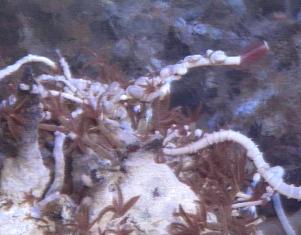 The water temperature near the vents can range from 300 degrees C at
the opening of the vent to only 1.5 degrees C 10-20 ft away. Animals
that live in this small oasis of life have made many adaptations to exist.
The unusual
animals found in this hostile habitat have only begun to be understood
over the last few years. Camera images and video from ROV (Remotely Operated
Vehicle) dives on the Juan de Fuca Ridge aid scientists in understanding
life near the hydrothermal vents on the seafloor. All animals in the vent
community depend on bacteria that
feed on hydrothermal chemicals from the vents. These bacteria are the
foundation of the ecosystem in this unusual habitat. The research vessel
Thompson
will continue the viewing and study of the vents' habitat. The Thompson
joined us today here at the Axial Volcano.
The water temperature near the vents can range from 300 degrees C at
the opening of the vent to only 1.5 degrees C 10-20 ft away. Animals
that live in this small oasis of life have made many adaptations to exist.
The unusual
animals found in this hostile habitat have only begun to be understood
over the last few years. Camera images and video from ROV (Remotely Operated
Vehicle) dives on the Juan de Fuca Ridge aid scientists in understanding
life near the hydrothermal vents on the seafloor. All animals in the vent
community depend on bacteria that
feed on hydrothermal chemicals from the vents. These bacteria are the
foundation of the ecosystem in this unusual habitat. The research vessel
Thompson
will continue the viewing and study of the vents' habitat. The Thompson
joined us today here at the Axial Volcano.
Join us tomorrow for the deployment of six new moorings. It will prove to be an exiting day on the Wecoma.
Fair seas,
Ms Deck.
Teacher Log #3 Tuesday 6/22/99
The Thomas G. Thompson
arrived on site at Axial volcano around 20:00 (8:00 p.m.) Monday night.
The science staff and technicians
eagerly began making final preparations for ROPOS first of many dives.
The first step in getting ROPOS in the water for a dive was to turn on
the transponders
left from the last cruise to Axial back in 1998. The transponders send
out an acoustic "ping" at a specific frequency. The time is takes for
the ping to reach the sub determines how far away the transponders are.
Triangulating several transponders allows one to determine the position
of ROPOS. 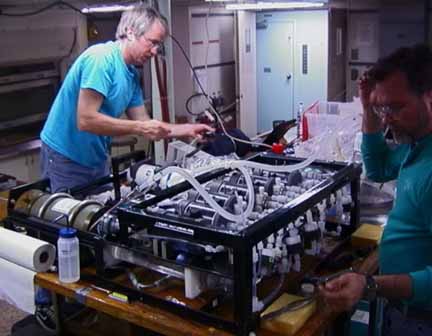 After the transponders located on the sea floor were turned on, the next
problem was in getting the vent fluid water sampler (photo left). Dive
time finally became a reality at about 03:00 (3:00 am) after many hours
of waiting. You must be a patient individual when on a research cruise.
(Boy will my wife be impressed, me being patient). DiveR482 never made
it to the bottom. This first attempt lasted a short time and depth (about
100 of the over 1500 meters it must travel to the bottom). Problems with
the air in the ROVs tether cable (umbilichord) caused the crew to raise
ROPOS back to the ship. On the second attempt, at about 06:00 (6:00 a.m.),
ROPOS made it down to slightly over 400 m before communication broke down
between the ship and the vent fluid sampler. Since one of the main goals
of this dive was the collection of water samples from the vent site #33,
it was canceled because no sampling and data was being collected.
After the transponders located on the sea floor were turned on, the next
problem was in getting the vent fluid water sampler (photo left). Dive
time finally became a reality at about 03:00 (3:00 am) after many hours
of waiting. You must be a patient individual when on a research cruise.
(Boy will my wife be impressed, me being patient). DiveR482 never made
it to the bottom. This first attempt lasted a short time and depth (about
100 of the over 1500 meters it must travel to the bottom). Problems with
the air in the ROVs tether cable (umbilichord) caused the crew to raise
ROPOS back to the ship. On the second attempt, at about 06:00 (6:00 a.m.),
ROPOS made it down to slightly over 400 m before communication broke down
between the ship and the vent fluid sampler. Since one of the main goals
of this dive was the collection of water samples from the vent site #33,
it was canceled because no sampling and data was being collected.
Scientists never stop working though. During the interval between the 1st and 2nd attempt of the ROPOS dive, scientists decided to use the CTD rossette sampler (photo above in science report)(Conductivity, Temperature, and Depth) for collecting water samples from a general area around and above the vent. The CTD sampler not only collects water samples but also analyzes the water it travel through on its way down which helps narrow down the target, providing scientists with "real time" data. Used for tracking "plume events", the relationship between the waters conductivity, temperature and the depth it is found in aids scientists to zero in on plumes or discharges of fluids from vents. This allows scientists to decide if a site in question is going to be a good one for sampling. In past explorations samples needed to be brought back on deck to be analyzed. You will read a lot about the "signatures" of vents and lava flows. This represents the chemical makeup of the water or rock in question. A signature may represent a large area or specifically small area. Water samples collected by the CTD sampler are now being analyzed. Julie Huber (University of Washington) a Thermophilic Microbiologist is using the water samples collected to look for microbes that are suspended within the vent fluids. Her goal is to determine if the microbes found here are common to all vent and oceanic ecosystems or if they are a very specific form, one that is only found here but not at other vent sites. One of the many studies going on here and around the world is the determination of micro and macro fauna of vent sites. Bacteria make up the basic ground floor level and a determination of where specifically these organisms actually live is an important part needed before other studies can be completed.
Christian Levesque ( University of Quebec in Montreal) is a Biologist seeking determine the relationships that develop based on the transference of nutrients from one organism to another (food chains and food webs). At the present time, water samples collected by CTD will be sealed up by Christian and sent back for analysis in Montreal. In Montreal, Christian will be trying to chemically determine the background signature of chemical elements in the vent fluid and sea water (there is a difference between the two so keep that in mind). Isotopes of carbon and nitrogen will hopefully be followed through the various organisms so as to identify the pathways within the ecosystem. No easy task for no air can come in contact with these samples or they become contaminated. So they must be handled carefully.
John Chadwick and Mike Perfit have been busy with collecting samples of lava flows using the rock corer. This simple device carries small plugs of wax that fragments of lava adhere to after the corer smashes down from its decent some 1500 m. The corer travels down at a rate of about 50m per minute. When the corer is retrieved, any and all fragments are removed from the wax for analysis back in labs at the University of Florida where John is working toward his Ph.D. under Mike. Working side by side in the lab, John removes the fragments from the wax with tweezers and Mike takes the remainder of the wax with the fine fragments and boils the wax in a cup of water to melt the wax away from the fragments. This appears to work great as the boiling water leaves behind numerous rock chips on the bottom of the cup. All the fragments are important. The more fragments you get, the wider the array of geochemical tests you can perform, and hopefully more information you can get from those tests. This is all just another step in coming to some conclusion about the history of Axial Volcano and trying to identify the geochemistry of the rocks along with the possible chemical evolution of this areas geology.
We are all back in the waiting mode, so scientists are back to checking equipment, going over maps for new site possibilities, and sleeping after the long night of waiting. Rock collecting is continuing as the vent fluid sampler goes in for repairs. The "elevator" is being prepared for the next dive (whenever that will be - remember patience) where samples of living creature along with sensing and data collecting equipment will be retrieved. Remember to send in your question and pass along our web site to your friends. Bye for now. Logbook of all Teacher At Sea postings
Questions & Answers
(oar.pmel.vents.webmaster@noaa.gov)